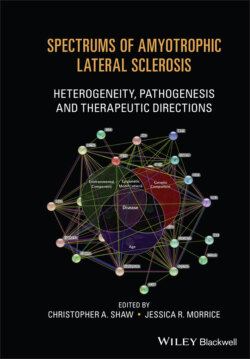Читать книгу Spectrums of Amyotrophic Lateral Sclerosis - Группа авторов - Страница 32
Chromosome 9 Open Reading Frame 72 (C9orf72)
ОглавлениеA hexanucleotide repeat expansion (HRE) of GGGGCC in the first intron of chromosome 9 open reading frame 72 (C9orf72) was discovered by two simultaneous studies [40, 41]. The locus containing C9orf72 was identified in linkage scans in large families with multiple ALS cases [42], but the actual variant was elusive due to the contemporary paradigm of searching for single nucleotide exonic variants. The C9orf72 HRE was the first noncoding variant with a substantial impact on ALS genetic research [4]. Currently the most common genetic cause of ALS, the C9orf72 HRE explains about 10% of all ALS cases (approximately 40% of familial and 7% of sporadic) [4]. The frequency of the C9orf72 HRE is strongly dependent on population, ranging from 20% of Finnish ALS cases to very rare in Asian populations [7]. Alleles in the range of 2 to 20 repeats are considered normal and non‐pathogenic, with repeat lengths above 30 being strongly penetrant for ALS. Indeed, repeat lengths of several thousand have been reported, with a potential correlation between disease severity and length [43]. Intermediate lengths between 20 and 30 repeats have been observed and have recently been recognized as associated with ALS, although with a lower risk than expanded alleles [44]. The C9orf72 HRE is unstable at very large repeat lengths [43], but somatic expansion of normal length does not likely occur [45].
Adding to the evidence that RNA metabolism is a significant factor in ALS pathology, C9orf72 HRE carriers show RNA foci and aberrant RNA translation. RNA foci result when HRE transcripts amass together and subsequently sequester RNA‐binding proteins [46]. For example, RNA‐binding proteins such as hnRNPA2B1 and hnRNPA1, as well as splicing factors SRSF1 and SRSF2, are also colocalized in RNA foci [46]. TDP‐43 has been observed to bind G‐quadruplex structures containing the GGGGCC repeat, implicating a loss of TDP‐43 function in C9orf72 ALS [47]. These sequestered proteins could have an impact on proper RNA splicing, and indeed transcriptomic aberrations have been observed in C9orf72 HRE patient cerebellums [48]. RNA foci are likely not toxic per se, as expressions of RNA containing only very long repeats (without the C9orf72 transcript) do not cause acute toxicity in Drosophila neurons [49]. While the C9orf72 HRE is in an intronic region of the pre‐spliced C9orf72 transcript, the repeat itself can be translated into dipeptide repeat proteins (DPRs) [50]. Through a process known as repeat‐associated non‐ATG‐initiated (RAN) translation, five different DPRs with two repeating amino acids each (depending on direction and reading frame) are generated. DPRs might affect ALS pathology in several ways. First, zebrafish models have demonstrated that expressing DPR without the C9orf72 HRE results in motor deficits and morphological defects [51]. Second, poly‐Gly‐Arg and poly‐Pro‐Arg DPR are toxic in Drosophilia neurons, and a mass spectrometry screen of proteins bound to DPR showed enrichment of ribosomal proteins, potentially linking translational inhibition [52]. Third, the poly‐Pro‐Arg DPR might alter proper nuclear pore function and affect nuclear import and export [53]. The direct effects of DPR on cell function and survival are still debated, and more study will be needed to determine whether the levels generated by inherited C9orf72 HRE are related to ALS progression.
